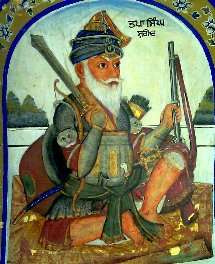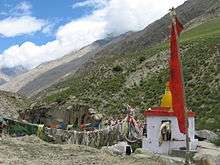Shaheed Shrine
A Shaheed Shrine is a building constructed to commemorate and show respect to a saint[1] and forms part of Punjabi folk religion in the Punjab region.
Punjabi Folk Cosmology
In Punjabi folk cosmology, the universe is divided into three realms:[2]
| English | Punjabi | Inhabitants |
|---|---|---|
| Sky | Akash | Dev Lok (Angels) |
| Earth | Dharti | Matlok (Humans) |
| Underworld | Naglok | Nagas (Serpents) |
Devlok is the realm of the gods, saints and ancestors, existing in akash, the sky.
A Shaheed can be martyred and hence achieve sainthood or can become a saint in the afterlife.
Although not part of organised religion, Shaheed Shrines only form part of Sikh and Muslim folk religion. However, such shrines are respected by all faiths.
Sikhs prefer to use the term Shaheed "jaggah" (but sometimes also use the term "smadh") whereas Muslims also use the term dargah or mazaar for such shrines if the shrine is near a grave. Muslim Shaheed Shrines typically represent Sufi saints.
The Hindus equivalent of Shaheeds are Siddhs of the Siddha tradition. Siddha shrines are either referred to as Mandirs or Samadhs.
Worship
Saint worship in shrines is common in the Punjab region.[3] People of all faiths attend and venerate shrines in honour of saints.
These shrines represent sources of power (barkat) to the common people and are open to people from all religious persuasions. The shrines can be at the final resting places of the saints (dargahs) or ‘memorial shrines’. [4] These memorial shrines have evolved into a distinct form of ‘saint worship’.[5] These shrines represent inter-communal dialogue and a distinct form of cultural practice of saint veneration.
Shrines
Shrines can be local, such as the shrine of Bhagat Baba Kalu[6] and Baba Nihal Singh Ji, [7] or they can be popular across a larger area forming part of folklore, such as the shrines of Sakhi Sarwar, also known as Baba Lakhadata whose larger central shrine is in Sakhi Sarwar of Dera Ghazi Khan District, Pakistan and the smaller shrine in Una, Himachal Pradesh, India.[8] Other popular shrines include those of Gugga Ji and Khawaja Khizr.
Photo gallery
- Shah Bilwal's Tomb, Muzzafargarh, Punjab, Pakistan
 Tapa Singh Shaheed
Tapa Singh Shaheed- Shrine Baba Budda Ji Nakodar
- Gurudwara Sahib & Baba Bala ji Smadh Ghuriana
 prayer flags Hindu shrine and red flag
prayer flags Hindu shrine and red flag- Bhagat Baba Kalu Ji Panchhat
References
- Sandip Singh Chohan, Thesis for the University of Wolverhampton: The Phenomenon of possession and exorcism in North India and amongst the Punjabi Diaspora in Wolverhampton
- Centre for Sikh Studies, University of California. Journal of Punjab Studies Fall 2004 Vol 11, No.2 H.S.Bhatti and D.M. Michon: Folk Practice in Punjab
- Replicating Memory, Creating Images: Pirs and Dargahs in Popular Art and Media of Contemporary East Punjab Landscape of Popular ‘Pirs’ Yogesh Snehi
- Replicating Memory, Creating Images: Pirs and Dargahs in Popular Art and Media of Contemporary East Punjab Yogesh Snehi page on Sufi shrines "Archived copy". Archived from the original on 2015-01-09. Retrieved 2015-01-09.CS1 maint: archived copy as title (link)
- Historicity, Orality and ‘Lesser Shrines’: Popular Culture and Change at the Dargah of Panj Pirs at Abohar,” in Sufism in Punjab: Mystics, Literature and Shrines, ed. Surinder Singh and Ishwar Dayal Gaur (New Delhi: Aakar, 2009), 402-429
- A Glossary of the tribes and castes of the Punjab & North-West Frontier Province, H.A.Rose, Ibbeston, Maclagan
- "Legend of Shahid Baba Nihal Singh". punjabjalandhar.info. June 2009.
- Replicating Memory, Creating Images: Pirs and Dargahs in Popular Art and Media of Contemporary East Punjab Yogesh Snehi page on Baba Lakhdata "Archived copy". Archived from the original on 2015-01-09. Retrieved 2015-01-09.CS1 maint: archived copy as title (link)